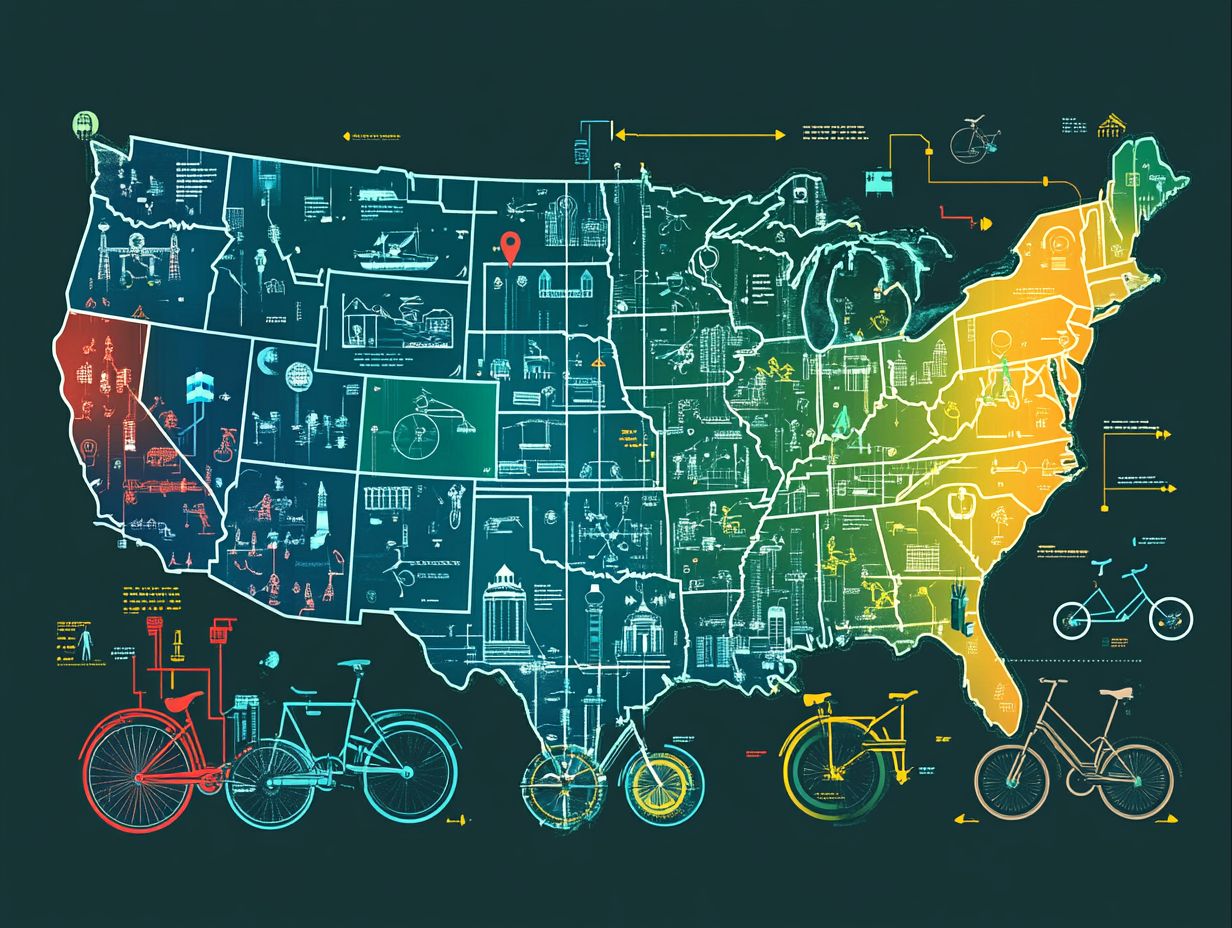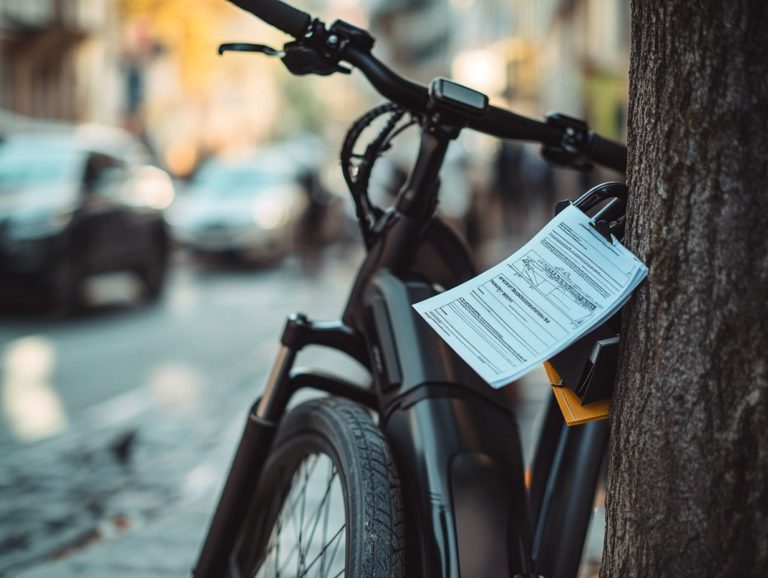Electric Bicycle Laws: A Comparison Between States
Electric bicycles, or electric bikes, are revolutionizing your daily commute. They present an eco-friendly alternative that is rapidly gaining traction across the nation.
As this trend takes off, you’ll encounter a varied landscape of regulations that can differ widely from state to state.
Let s explore the crucial laws surrounding electric bikes, including federal and state laws, helmet requirements, age restrictions, and maximum speed limits.
You ll discover how these rules affect you as a rider and engage in a discussion about potential improvements, ensuring you remain informed and safe on your e-bike journeys.
Contents
- Key Takeaways:
- 1. Understanding Electric Bicycles and Their Classification
- 2. Federal Regulations for Electric Bicycles
- 3. State Laws for Electric Bicycles
- 4. Helmet Laws for Electric Bicycles
- 5. Age Restrictions for Riding an Electric Bicycle
- 6. Speed Limits for Electric Bicycles
- 7. Road and Bike Lane Regulations for Electric Bicycles
- 8. Licensing and Registration Requirements for Electric Bicycles
- 9. Insurance Coverage for Electric Bicycles
- 10. Riding Under the Influence of Alcohol or Drugs
- 11. Penalties for Violating Electric Bicycle Laws
- 12. Differences in Laws Between States
- 13. How Do These Laws Affect Electric Bicycle Riders?
- 14. What Are the Benefits of Having Specific Electric Bicycle Laws?
- 15. What Changes Can Be Made to Improve Electric Bicycle Laws?
- Frequently Asked Questions
- What Makes Electric Bicycles Different from Traditional Bikes?
- Are There Different Classes of Electric Bicycles and How Do They Impact Laws?
- Do All States Have Specific Laws for Electric Bicycles?
- How Do Electric Bicycle Laws Vary Between States?
- Can Electric Bicycles Be Ridden on Sidewalks?
- Do Electric Bicycle Laws Apply to All Types of E-Bikes?
Key Takeaways:

- Know your bike’s classification and follow your state’s regulations.
- Understand the age restrictions and speed limits before riding.
- Follow electric bicycle laws to ensure your safety and clarify your rights.
1. Understanding Electric Bicycles and Their Classification
Electric bicycles, or e-bikes as they’re commonly known, have surged in popularity as a chic and eco-friendly way to get around. This rise has sparked the creation of a detailed classification system that divides them into three distinct classes: Class 1, Class 2, and Class 3.
Each class is defined by its level of assistance and maximum speed, which can vary based on state laws. They each boast unique features that cater to different types of riders.
- Class 1 e-bikes provide pedal-assist only, meaning the motor kicks in only when you’re pedaling. The assistance cuts off once you hit 20 mph.
- Class 2 bikes, in contrast, come equipped with a throttle option, allowing you to engage the motor without pedaling, also limited to a top speed of 20 mph.
- Class 3 models take it up a notch, assisting up to 28 mph. They often include additional safety features and may have specific regulations, such as requiring you to wear a helmet while riding.
Understanding these classifications is essential, especially in states like California, Florida, and New York, where e-bike legislation varies.
2. Federal Regulations for Electric Bicycles
Federal regulations surrounding electric bicycles create a fundamental framework for how e-bikes operate and are classified throughout the United States. These regulations enhance safety and compliance while encouraging non-motorized travel.
They categorize e-bikes into three distinct classes, determining their usage based on speed and power assistance. This federal oversight aligns seamlessly with state legislation, allowing for local adjustments that address specific community needs and safety concerns.
For example, some states may impose stricter rules regarding where e-bikes can be ridden. This affects access to public roadways and designated bicycle paths. The interaction between these federal guidelines and local ordinances directly influences how you can enjoy your rides, impacting everything from where e-bikes can operate to the equipment you need for compliance.
3. State Laws for Electric Bicycles
State laws surrounding electric bicycles, including a detailed three-class system, can be quite complex. States like California, Florida, and New York each craft their own regulations. These laws reflect local authorities efforts to balance safety, accessibility, and the promotion of e-bikes as a viable transportation option.
In California, for example, you must be at least 16 years old to ride Class 3 e-bikes, which can reach speeds of 28 mph. If you’re looking to learn more about the legal requirements, check out the understanding electric bicycle laws in California. In contrast, Florida allows riders of any age for Class 1 and 2 e-bikes, which require pedal assistance and have a top speed of 20 mph. Meanwhile, New York has recently revamped its e-bike legislation, introducing age restrictions while prioritizing safety measures.
Local authorities enforce these laws with varying degrees of rigor. They often partner with advocacy organizations like PeopleForBikes, including the Bureau of Land Management and National Parks, to educate the public, ensure compliance, and promote responsible riding practices. This highlights the dynamic landscape of electric bicycle regulations unfolding across the country.
Stay informed about your local e-bike laws to enjoy safe rides!
4. Helmet Laws for Electric Bicycles
Do you know the helmet laws in your area? Helmet laws for electric bicycles are vital for ensuring your safety on the road. Regulations vary widely across states and local governments, determining whether you must wear a helmet while riding your e-bike on public roadways and bike lanes.
Understanding these laws is crucial, whether you’re a newbie or a seasoned rider. Ignoring them could result in fines and elevate the risks you face in the event of an accident.
Some states require all riders to wear helmets, while others impose specific age restrictions or don t mandate helmets for certain types of e-bikes at all.
This patchwork of regulations impacts you as an individual rider and shapes how e-bikes fit into local infrastructure. It influences community safety initiatives and insurance liabilities.
By staying informed about these laws, you ensure compliance and contribute to a safer riding environment for everyone involved.
5. Age Restrictions for Riding an Electric Bicycle

Age restrictions for riding electric bicycles are put in place to enhance safety and encourage responsible usage. Many states have specific age requirements that you must follow when navigating public roadways and bike lanes.
These regulations often focus on younger riders, reflecting a widespread concern for their safety and experience levels, particularly in relation to age requirements for different classes of e-bikes.
For instance, while some regions permit riders as young as 14 to hop on electric bikes, others set the minimum age at 16 or even 18. The reasoning behind this varies; state legislators contend that younger individuals might lack the maturity or judgment needed for safe riding, particularly in bustling urban settings.
Such restrictions can significantly impact accessibility for young people, curtailing their mobility options and limiting their ability to engage in outdoor activities.
This connects to the larger push for eco-friendly lifestyles, and can be frustrating for young eco-warriors eager to embrace a greener lifestyle!
6. Speed Limits for Electric Bicycles
Speed limits for electric bicycles play a vital role in ensuring safety on shared roadways and bike lanes. Many states have established different maximum speed thresholds based on the class of e-bike, which directly influences the operational rules you must follow as a rider.
For example, Class 1 e-bikes typically cap out at 20 mph when pedaled. Class 2 models, which can operate solely on motor power, often share a similar limit, although some jurisdictions allow them to reach speeds of up to 28 mph.
This distinction reflects local safety measures designed to accommodate various types of riders and terrains. Adhering to these regulations is not just a legal requirement; it promotes a safer riding experience for everyone on the road drivers, cyclists, and pedestrians alike.
Understanding the specific laws in each state helps you navigate different environments safely.
7. Road and Bike Lane Regulations for Electric Bicycles
Regulations governing the use of electric bicycles on roadways and bike lanes are vital for fostering a harmonious coexistence between cyclists and motorized vehicles. Local regulations significantly influence how e-bikes are allowed to navigate these spaces.
You ll find that these regulations can vary widely from one jurisdiction to another, compelling local authorities to establish clear guidelines that dictate where and how e-bikes can operate.
By implementing designated lanes, speed limits, and safety requirements, municipalities play a crucial role in shaping the e-bike landscape, balancing the needs of commuters, recreational users, and drivers alike.
Effective enforcement of these regulations, including license registration for certain classes, is paramount. Local law enforcement agencies must ensure compliance while educating the public about the importance of sharing roadways responsibly.
This collaborative approach enhances safety and promotes the growth of sustainable transportation methods, paving the way for a greener future.
8. Licensing and Registration Requirements for Electric Bicycles
Licensing and registration requirements for electric bicycles can vary significantly from state to state. Some jurisdictions require registration for specific classes of e-bikes like Class 1, Class 2, and Class 3. This can influence how you interact with your vehicle while following local rules.
Take California, for example. Here, electric bicycles are divided into three classes based on their capabilities. If you own a Class 3 e-bike that exceeds a certain speed, registration becomes necessary. For a detailed comparison, you can refer to the electric bicycle types comparison chart. In contrast, some states don’t require any registration, allowing you to enjoy your e-bike without bureaucratic hassle.
These differences can greatly impact your ownership experience, especially if you plan to use your e-bike for commuting or recreation. Understanding navigating electric bicycle licensing requirements is crucial for any e-bike enthusiast who wants to ride lawfully and enjoy every moment on the road.
9. Insurance Coverage for Electric Bicycles
Insurance coverage for electric bicycles is increasingly important as more riders take to the roads. Various policies are specifically tailored for e-bikes, offering protection against damages and liabilities.
These policies typically include comprehensive coverage options that address:
- Accidents and theft
- Liability for injuries caused to others
Costs can vary significantly based on factors such as desired coverage levels, the value of your e-bike, and your riding history.
Having insurance provides peace of mind. It allows you to enjoy your rides without worrying about potential financial losses. It’s crucial to explore the options available to safeguard your investment and ensure a worry-free e-biking experience.
10. Riding Under the Influence of Alcohol or Drugs

Riding electric bicycles while under the influence of alcohol or drugs is a serious issue, with operating rules varying by state. These regulations address the legal implications and safety hazards associated with impaired riding.
Such rules aim to deter reckless behavior and protect both the rider and everyone sharing the road. In many jurisdictions, if you re caught riding an e-bike while intoxicated, you could face serious penalties, including:
- Hefty fines
- License suspensions
- Criminal charges
Beyond legal consequences, be aware of the heightened risk of accidents and injuries from impaired judgment and coordination. Riding responsibly ensures your personal safety and contributes to a safer environment for pedestrians, cyclists, and motorists alike, emphasizing the shared responsibility of all road users.
11. Penalties for Violating Electric Bicycle Laws
Penalties for violating electric bicycle laws can vary widely, ranging from fines to the confiscation of your e-bike. These measures serve as a deterrent to unsafe riding practices and encourage compliance with the rules.
Penalties can address a range of infractions, including:
- Neglecting to wear a helmet
- Exceeding speed limits
For example, if you’re caught riding without a helmet, you might face a fine. Ignoring designated bike lanes could lead to more severe penalties. In some areas, repeat offenders risk having their e-bike confiscated, highlighting the seriousness of these violations.
Following the rules isn t just smart it s essential for your safety and the safety of everyone around you!
12. Differences in Laws Between States
The differences in electric bicycle laws across states like California, Florida, and New York showcase the intricate regulatory landscape you must navigate. Local regulations affect everything from classifications to operational rules and safety requirements.
These variations can profoundly impact how you engage with electric bikes in your daily life. For example, California’s comprehensive three-class system fosters inclusivity, enhancing your access to and use of e-bikes. On the flip side, Florida’s more relaxed regulations might spark innovation, but they can also create confusion around safety standards. To better understand these differences, check out the electric bicycle regulations: a global overview.
In New York, strict helmet laws prioritize safety. However, they may discourage inexperienced cyclists from using e-bikes. Such discrepancies not only shape your riding experience but also influence broader trends like urban planning and environmental initiatives, ultimately affecting the future of electric mobility. To understand how these laws vary, check out the state-specific electric bicycle legal frameworks.
13. How Do These Laws Affect Electric Bicycle Riders?
The many laws and regulations surrounding electric bicycles greatly influence your riding experience. They shape how you interact with local authorities and determine whether e-bikes are a viable mode of transportation for you.
These regulations dictate where and how you can use these eco-friendly vehicles, while also impacting safety measures that encourage better practices among riders. For instance, knowing the top 5 electric bicycle laws is crucial, as in some cities, helmet usage is mandatory, which has been shown to significantly reduce accident rates. Many riders report that clear laws enhance their sense of security. Local surveys reveal that communities with stringent regulations tend to view e-bikes more favorably.
This growing acceptance fosters broader usage, ultimately improving accessibility for various demographic groups, including those who might otherwise find traditional bikes unaffordable or impractical.
14. What Are the Benefits of Having Specific Electric Bicycle Laws?
The implementation of specific laws governing electric bicycles offers many benefits, enhancing not only rider safety but also promoting the seamless integration of e-bikes into existing transportation systems. This boosts non-motorized travel and helps reduce traffic congestion.
Regulations often improve infrastructure, featuring dedicated bike lanes and enhanced signage, making the roads safer for everyone. When you feel secure while riding, you re more inclined to choose e-bikes as a sustainable commuting option, which drives up ridership rates.
Cities like Amsterdam and Copenhagen serve as prime examples of this success. Their clear e-bike laws have embraced the burgeoning trend and cultivated a lively cycling culture. These regulations can significantly mitigate accidents by mandating essential safety features, ultimately fostering a community that prioritizes eco-friendly transportation solutions.
15. What Changes Can Be Made to Improve Electric Bicycle Laws?

Proposed changes to electric bicycle laws can greatly enhance safety, accessibility, and understanding of regulations. Advocates urgently call for updates that reflect the rapidly evolving world of e-bike technology and its usage patterns.
These updates could offer clearer definitions of what exactly qualifies as an electric bicycle, along with tiered regulations based on power output. To better understand the rules in your area, you can check the electric bicycle age restrictions by state. This approach would facilitate the coexistence of various e-bike classes alongside traditional bicycles harmoniously.
Advocacy groups like PeopleForBikes recommend integrating e-bikes into existing bike lane structures, ensuring local authorities have the necessary guidelines to promote safe usage and develop proper infrastructure.
Embracing these changes can spark a cycling revolution in the community! More riders mean less congestion and cleaner air for everyone.
Frequently Asked Questions
What Makes Electric Bicycles Different from Traditional Bikes?
An electric bicycle, or e-bike, is a bike equipped with an electric motor that helps with movement. This allows it to reach higher speeds and requires less physical effort to ride.
Are There Different Classes of Electric Bicycles and How Do They Impact Laws?
Yes, there are three classes of electric bicycles based on their top speed and type of pedal assistance. Class 1 and Class 2 e-bikes can go up to 20 mph with pedal assistance, while Class 3 e-bikes can reach speeds up to 28 mph.
The classification can affect laws and regulations in different states.
Do All States Have Specific Laws for Electric Bicycles?
No, not all states have specific laws for electric bicycles. Many states have adopted the federal definition of e-bikes and implemented their own regulations for use on roads and bike paths.
How Do Electric Bicycle Laws Vary Between States?
Electric bicycle laws differ by state in terms of classification, speed limits, and age restrictions. Some states even require riders to wear helmets or have a valid driver’s license to operate an e-bike.
Can Electric Bicycles Be Ridden on Sidewalks?
The legality of riding an electric bicycle on sidewalks varies by state. While some states allow it, others prohibit it. It’s crucial to check your local laws before riding an e-bike on a sidewalk.
Do Electric Bicycle Laws Apply to All Types of E-Bikes?
No, electric bicycle laws may not cover all types of e-bikes. Some states have separate regulations for electric scooters and skateboards, while others focus on e-bikes that meet certain speed and power requirements.
Always check the specific laws for your type of e-bike in your state.
Want to know more about electric bicycles and their laws? Explore your local regulations!





